Détail du document
Identifiant
oai:arXiv.org:2409.04828
Sujet
Computer Science - Computer Vision... Computer Science - Artificial Inte... Computer Science - MultimediaAuteur
Liu, Yuan Zhao, Zhongyin Zhuang, Ziyuan Tian, Le Zhou, Xiao Zhou, JieCatégorie
Computer Science
Année
2024
Date de référencement
13/11/2024
Mots clés
science strategies data computerRésumé
In recent years, vision-language models have made significant strides, excelling in tasks like optical character recognition and geometric problem-solving.
However, several critical issues remain: 1) Proprietary models often lack transparency about their architectures, while open-source models need more detailed ablations of their training strategies.
2) Pre-training data in open-source works is under-explored, with datasets added empirically, making the process cumbersome.
3) Fine-tuning often focuses on adding datasets, leading to diminishing returns.
To address these issues, we propose the following contributions: 1) We trained a robust baseline model using the latest advancements in vision-language models, introducing effective improvements and conducting comprehensive ablation and validation for each technique.
2) Inspired by recent work on large language models, we filtered pre-training data using perplexity, selecting the lowest perplexity data for training.
This approach allowed us to train on a curated 1M dataset, achieving competitive performance.
3) During visual instruction tuning, we used model soup on different datasets when adding more datasets yielded marginal improvements.
These innovations resulted in a 9B parameter model that performs competitively with state-of-the-art models.
Our strategies are efficient and lightweight, making them easily adoptable by the community.
;Comment: v2
Liu, Yuan,Zhao, Zhongyin,Zhuang, Ziyuan,Tian, Le,Zhou, Xiao,Zhou, Jie, 2024, POINTS: Improving Your Vision-language Model with Affordable Strategies

Projection-Specific Heterogeneity of the Axon Initial Segment of Pyramidal Neurons in the Prelimbic Cortex
heterogeneity projection-specific

